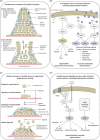The trans-kingdom identification of negative regulators of pathogen hypervirulence
- PMID: 26468211
- PMCID: PMC4703069
- DOI: 10.1093/femsre/fuv042
The trans-kingdom identification of negative regulators of pathogen hypervirulence
Abstract
Modern society and global ecosystems are increasingly under threat from pathogens, which cause a plethora of human, animal, invertebrate and plant diseases. Of increasing concern is the trans-kingdom tendency for increased pathogen virulence that is beginning to emerge in natural, clinical and agricultural settings. The study of pathogenicity has revealed multiple examples of convergently evolved virulence mechanisms. Originally described as rare, but increasingly common, are interactions where a single gene deletion in a pathogenic species causes hypervirulence. This review utilised the pathogen-host interaction database (www.PHI-base.org) to identify 112 hypervirulent mutations from 37 pathogen species, and subsequently interrogates the trans-kingdom, conserved, molecular, biochemical and cellular themes that cause hypervirulence. This study investigates 22 animal and 15 plant pathogens including 17 bacterial and 17 fungal species. Finally, the evolutionary significance and trans-kingdom requirement for negative regulators of hypervirulence and the implication of pathogen hypervirulence and emerging infectious diseases on society are discussed.
Keywords: antimicrobial resistance; bacteria; emerging infectious diseases; fungi; pathogen; virulence.
© FEMS 2015.
Figures








Similar articles
-
The Pathogen-Host Interactions database (PHI-base): additions and future developments.Nucleic Acids Res. 2015 Jan;43(Database issue):D645-55. doi: 10.1093/nar/gku1165. Epub 2014 Nov 20. Nucleic Acids Res. 2015. PMID: 25414340 Free PMC article.
-
PHI-base in 2022: a multi-species phenotype database for Pathogen-Host Interactions.Nucleic Acids Res. 2022 Jan 7;50(D1):D837-D847. doi: 10.1093/nar/gkab1037. Nucleic Acids Res. 2022. PMID: 34788826 Free PMC article.
-
Transcriptome Sequencing Approaches to Elucidate Host-Microbe Interactions in Opportunistic Human Fungal Pathogens.Curr Top Microbiol Immunol. 2019;422:193-235. doi: 10.1007/82_2018_122. Curr Top Microbiol Immunol. 2019. PMID: 30128828 Review.
-
Host specificity determinants as a genetic continuum.Trends Microbiol. 2012 Feb;20(2):88-93. doi: 10.1016/j.tim.2011.11.006. Epub 2011 Dec 21. Trends Microbiol. 2012. PMID: 22196375 Review.
-
New and old ways of understanding microbial pathogenesis.Trends Microbiol. 2000 Feb;8(2):53-5. doi: 10.1016/s0966-842x(99)01680-7. Trends Microbiol. 2000. PMID: 10755832 No abstract available.
Cited by
-
A spatial temporal analysis of the Fusarium graminearum transcriptome during symptomless and symptomatic wheat infection.Mol Plant Pathol. 2017 Dec;18(9):1295-1312. doi: 10.1111/mpp.12564. Epub 2017 Aug 8. Mol Plant Pathol. 2017. PMID: 28466509 Free PMC article.
-
PHI-base: a new interface and further additions for the multi-species pathogen-host interactions database.Nucleic Acids Res. 2017 Jan 4;45(D1):D604-D610. doi: 10.1093/nar/gkw1089. Epub 2016 Dec 3. Nucleic Acids Res. 2017. PMID: 27915230 Free PMC article.
-
Identification of significant SNPs and candidate loci for blast disease resistance via GWAS and population structure analysis in ARC panel of Oryza sativa.Physiol Mol Biol Plants. 2024 Oct;30(10):1673-1689. doi: 10.1007/s12298-024-01518-6. Epub 2024 Oct 26. Physiol Mol Biol Plants. 2024. PMID: 39506992
-
Antivirulence and avirulence genes in human pathogenic fungi.Virulence. 2019 Dec;10(1):935-947. doi: 10.1080/21505594.2019.1688753. Virulence. 2019. PMID: 31711357 Free PMC article. Review.
-
A protein that controls the onset of a Salmonella virulence program.EMBO J. 2018 Jul 13;37(14):e96977. doi: 10.15252/embj.201796977. Epub 2018 Jun 1. EMBO J. 2018. PMID: 29858228 Free PMC article.
References
-
- Anderson PK, Cunningham AA, Patel NG, et al. Emerging infectious diseases of plants: pathogen pollution, climate change and agrotechnology drivers. Trends Ecol Evol. 2004;19:535–44. - PubMed
-
- Andersson DI, Hughes D. Antibiotic resistance and its cost: is it possible to reverse resistance? Nat Rev Microbiol. 2010;8:260–71. - PubMed
-
- Ausubel FM. Are innate immune signaling pathways in plants and animals conserved? Nat Immunol. 2005;6:973–9. - PubMed
Publication types
MeSH terms
Grants and funding
- BB/I001077/1/BB_/Biotechnology and Biological Sciences Research Council/United Kingdom
- BB/I000488/1/BB_/Biotechnology and Biological Sciences Research Council/United Kingdom
- BB/J/004383/1/BB_/Biotechnology and Biological Sciences Research Council/United Kingdom
- BB/I/001077/1/BB_/Biotechnology and Biological Sciences Research Council/United Kingdom
- BB/K020056/1/BB_/Biotechnology and Biological Sciences Research Council/United Kingdom
LinkOut - more resources
Full Text Sources
Other Literature Sources
Medical
Molecular Biology Databases

